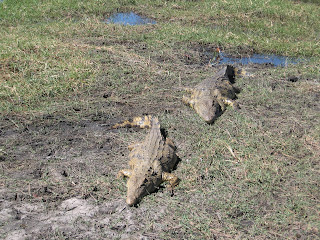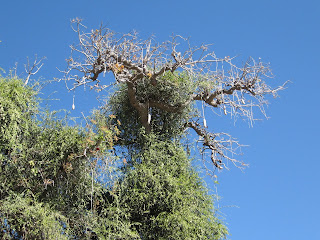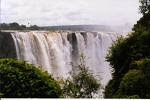Sunday is another early day but without the sex. The day before we got into the kitchen early for breakfast, then found another (free) breakfast waiting for us at the river. So today we skip the kitchen and expect breakfast to be part of the safari – it isn’t. A van picks us up at the hostel and we are driven about 25 miles to the Botswana border. With us are two young women from NY who are in Zambia working for an education charity, two teen-age boys with ipods and the boys’ parents.
The border crossing is actually a ferry. The river is about 200 meters across at this point, there are several small boats carrying pedestrians and larger ferries carrying the semi-trailers. Trucks must wait a day or more to cross here. I wonder what a bridge would do for interstate commerce. On the far side we find the jeeps waiting for us. We pile in quickly; there are already many other jeep loads here who’ve been waiting. Several other college girls from Utah, also from our hotel, left an hour before us. So yeah, I’m with 2 college age men and what, 15 prospective dates. It’s going to be an interesting day.

The jeeps take us to the entrance of Chobe Park in northern Botswana. Chobe Park is home to the largest concentration of elephants on earth. (Kelly, you should probably check it out.) But before we go into the park we have a boat tour of the confluence of the Chobe and Zambezi rivers.

We board the flat-bottomed boat and pick a seat at the railing. The next group to board is about 25 Korean tourists. These folks did not forget breakfast: they’ve brought it with them. Even after living in Korea for a year, I never developed a taste for dried fish and seaweed. On the positive side of things I’m no longer hungry.
The area is marshy with a large island in the middle. The entire area is swarming with wildlife. The boat glides around the marsh, easing up to hippos, crocodiles, buffalo, and numerous birds. Almost every animal is nonplussed by our presence.

The crocodiles are especially still, rarely moving in any amount. They preferr to bask in the sun and digest their last meal. These two are about 7 feet long, nose to tail. The hippos are a bit more temperamental, usually drifting off as the boat approaches. We are never close enough for the little digital to capture the scene. Yes, I need a new camera.
Jack has seen numerous elephants in Africa, but has yet to see any drinking. Well today he gets his wish. The boat rounds a bend in the river to find two elephants. Both are drinking and edging into the water. It’s a very rhythmic process watching them pull in the river water, I’d be interested to know how much a snootfull of water amounts to.

These two are also not terribly put off by our presence but they prefer more privacy as well: they amble off down the river bank trying to keep a comfortable distance.

Elephant not actual size
One of the more interesting animals was the African Darter. The Darter is a fishing bird, mostly black but unlike other aquatic birds, this one does not excrete any oil. So the bird spends a great deal of time trying to dry off. At first I wondered if they were trying to be intimidating. But no, they just stand in the marsh with wings spread, looking like they should be on top of a flag-pole.

I was prepared to see the elephants, hippos and crocodiles; ready to see each one “in the wild” so to speak. But I was not ready, or not expecting to see so many other aspects of the wild life in Africa. There are numerous types of antelope here, some large, single and majestic, others smaller, quick and numbered in herds. The impalas and pukus were the most numerous. The impalas are relatively easy to pick out because each one has the letter “M” tattooed on their ass. Down each leg and on either side of the tail is a dark stripe, so when the tail is still – M.
But I preferred the larger variety of antelopes, the Kudu and most of all the Sable. We saw one Kudu marching down the beach:

Male Kudu
If you can’t tell from the photo, this animal is easily twice the size of the implala behind, perhaps even larger. It has thin white vertical stripes and resembles the bongo, but this one is obviously gray, not red. This guy was pretty much master of his area and was not going to be rushed along by any tourists.
Yes, there were plenty of hippos, and many more photos of the elephants, but those will have to wait.

Amazing to see the transition of the tourists. At first everyone was flocking to the roof deck for a better view, or crushing against the railing for a close up picture of the animals. After an hour the scene is much more tame and everyone seems to be more involved conversing with each other. Dan and Jack take this opportunity to chat with all the young ladies. Most of the girls are from the western US and about half are only in Africa for two weeks, with this safari weekend thrown in the middle. As for me, I’m starting to wonder more and more about lunch.
We go to one of the lodges for Chobe park, where they have set up a buffet for us. It’s very nice, but the pool seems to beckon since the day has warmed up considerably. At the pool I talk to a young Scandinavian couple that are spending two years in South Africa teaching music. They really seem to be enjoying what they are doing, teaching jazz, but part of me wonders if there’s a limit to what charities should be doing.
After lunch, we climb back into the jeeps for the afternoon ride. We drive into Chobe Park to see what we will see. Elephants are a foregone conclusion here, but we are each anxious to see what else the park holds – namely cats.
As we enter, the guide slows down enough to point out some shrubs. In these, he says, are where the cats spend most of the day. What he doesn’t say is that they are unlikely to stay too close to where jeeps are driving along at 40kmh. Here’s a picture of the diurnal feline habitat.

Look closely!
Our guide is obviously a practitioner of the PT Barnum school of Safaris.
These shrubs continue for quite a while, in a few places they give way to a grave yard of trees – areas where elephants have stopped to eat. They not only strip the leaves, but the bark and then seem to knock the trunk over when they’re done.

A bit further, the trail comes to a flood plain of the Chobe river. Here we find more hippos and several wart-hogs. The wart-hog is just plain ugly. He spends his day on his front knees so he can burrow his ugly mug deeper into the ugly mud to dig up what must be ugly pills.

Mud Ugly!
Behind ugly there is a zebra, we only see a few. The driver is adamant that we are pronouncing the name wrong and corrects us many times (a soft ‘e’), so it becomes a bit of sport for us. Next we see the most majestic animal of the day: the Sable Antelope. He is the largest type of antelope we see all day, similar to a Burmese mountain dog in colors. Most impressive is his huge rack. Beautiful horns that curve gracefully almost completely to his back. He strides past with all the regal bearing of a Windsor.

His Majesty
Nearly all the animals we see move with a sedate calm. As if none of them want to upset the grandeur of the setting or the peaceful calm of the day. That was left to us, roaring around in our jeeps. There are about half a dozen vehicles visible in the flood plain (we can see a little more than a mile of the trail). Each car stops to see the same animals in turn. And then we turn around, as if the tour is over.
No way! I think, that can’t be it. Where are the cats? the giraffes? This place is supposed to be crawling with elephants. Where’s my money? But we do turn around, the day is getting on and we have to be back in Livingstone by 5PM. The trail back leaves the Chobe river. We almost immediately start to see giraffes, first just a head above the trees and then, as we are straining to see one in the distance on our left, we pull immediately in front of two on the right. Traffic jam in Chobe.

Giraffes have a talent for cropping their own photos
I cannot not zoom back any farther, we are 20’ from this guy, he must be over 15’ tall. The giraffe behind is as impatient with traffic as I am, he goes looking for another way to the water. The giraffe in front seems just as curious as we are - until he starts to groan a bit, so we move on. As we watch him go, someone notices an eagle. The fish eagle is actually the national bird of Zambia and once we notice them, we can see them all over the reserve; they resemble our own bald eagles, but the white extends further, like a cape.

Fish Eagle
Zambian / Zimbabwean National Bird
In the distance we can see hundreds of other large birds collected densely in just a few trees. As we approach it is obvious they are vultures. I think they are all full, below them is a large elephant who had died several days earlier. Surprising that after such a long time he is still nearly complete.
Not much further up the trail we finally find a small family of elephants, three adults, a couple younger ones and an infant.

The larger animals surrounding and protecting the little guy
I feel much better as we continue on out of the park. We’ve seen nearly every animal we were looking for except the cats, who are much more nocturnal. Rhinos would have been a great addition, but there are only a few in this area of the world, perhaps half a dozen in the border areas of Zambia and Botswana. Before we leave the park we come to a major jam: Chobe Chicago style. There are now elephants everywhere. A herd of about 30 are crossing the trail, the jeep in front of us is nose to nose with two.

Once that jeep gets by we try to ease by ourselves without causing a raucous. Not only are the elephants a bit indignant that we are interrupting their sojourn, they are also nervous about the 4-5 very young in their midst.

A very young elephant is barely visible in the trees
This was the last calm moment of the bull on the left; as we pass he turns and flares at us, shaking his head and stamping one foot. It is extremely impressive, and being in the jeep did nothing for my feeling of security, or lack thereof. We pass only 4 feet from him. I am tempted to take a photo, but the camera whirring and clicking doesn't seem like a good idea.
The last view of the park is the sausage trees. Too good to be true, but it sure looks real

Sausages!
When we get back to Livingston, we take 10 of the girls we met on the safari and go to an 'authentic' African restaurant. The guys and I are interested in the crocodile steaks. These are great! The side dishes are interesting, most of the them are an odd collection of vegetables; they are very bland and designed to accompany the nshima. I don’t like nshima. But I do enjoy the dancing ritual that takes place after dinner. Some locals try to display authentic zulu dress along with a ritual mating dance. I think the choice of zulu is curious, since they were invaders in this area. But the dance is neat. Especially when the dancers came to our table and collect all the young men and women to join them. Thankfully, I am left to observe – and document the event. Everyone has a great time.
The next day we are up early again. Knowing how torturous the bus ride could be we are emphatic in our goal of riding a more comfortable “business class” bus. That bus leaves at 6AM. The ride is fine, much better than before. But as we get close to town, the driver begins to make stops for individual passengers. Imagine my disbelief building as we stop every mile or two. The frosting on this cake: the bus pulls into a gas station. I can see the center of town about a mile away and we are going to fill up. 5-10 minutes for a car, how long for a bus? So I grab my bags and we walk to the main interchange where we catch a cab. I’m not sure why I thought the bus would actually go to the terminal, I’m sure the driver was equally confused by my expectations. In the end we are back at ‘home’ by 2PM, it’s a beautiful day. We spend much of the afternoon comparing photos and trying to figure out how to post the videos on the web. But the service here is just to slow. You’ll have to wait.




No comments:
Post a Comment